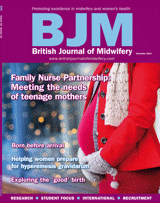References
90 seconds to change the world
Abstract
Student midwife Paulina Sporek discusses the importance of delayed cord clamping.
At the moment a baby is born, about a third of its blood is outside of its body. Physiological studies have shown that, of the total blood volume in the combined fetal–placental circulation at full gestation, approximately 25–60% is found in the placental circulation. This blood is known to be rich in hematopoietic stem cells (Wardrop and Holland, 1995; Dixon, 1997).
The optimal timing of cord clamping has been a controversial issue for decades. For many years, it was advised that the cord was cut immediately following birth. However, the World Health Organization (WHO, 2012) no longer recommends this because a delay in clamping the cord allows continued passage of blood from the placenta to the baby for an additional 1 to 3 minutes after birth. This brief delay could help prevent iron deficiency from developing before 6 months of age in babies born at full term (Chaparro et al, 2006). Despite that, most practitioners in Western countries clamp and cut cord immediately after birth (Mercer, 2001). Early cord clamping, compared with delayed clamping, has no beneficial evidence-base. There is, however, credible evidence that it results in a decrease to the neonate of 20–40 mL of blood per kilogram of body weight, which would provide the equivalent of 30 to 35 mg of iron (Hutton and Hassan, 2007). Resulting in a subsequent decrease in oxygen and stem cells.
Register now to continue reading
Thank you for visiting British Journal of Midwifery and reading some of our peer-reviewed resources for midwives. To read more, please register today. You’ll enjoy the following great benefits:
What's included
-
Limited access to our clinical or professional articles
-
New content and clinical newsletter updates each month

